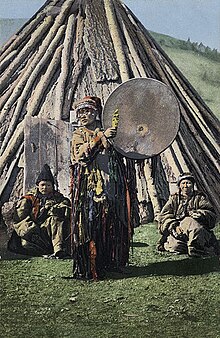騰格里信仰

騰格里信仰是突厥人、蒙古人、匈人和匈奴等中亞游牧民族的傳統信仰[1],帶有薩滿教、泛靈信仰、圖騰崇拜和祖先崇拜色彩。騰格里信仰以一神論思想為主[2][3],崇拜中心神靈騰格里(突厥語:𐱅𐰭𐰼𐰃 ẗŋr̈y→täŋri、täŋäri或täŋiri;保加利亞語:Тангра Tangra;土耳其語:Tanrı;蒙古語:ᠲᠩᠷᠢ Tngri;達斡爾語:tangar /təŋgər/[4];哈薩克語:تاڭىر Тәңір 回鶻語:![]() /tängri/;維吾爾語:تەڭرى tengri[5])。後由於受到佛教、印度教等影響,騰格里被加上各種稱呼,分裂成為眾多神靈,17世紀後甚至出現「九十九騰格里」的說法,有學者因而稱之為「一神論和多神論的結合」[6]。在歐洲,可薩人、保加爾人、馬扎爾人[7]和阿瓦爾人也曾信仰騰格里[8]。騰格里信仰也是歷史上突厥汗國、西突厥汗國、舊大保加利亞和保加利亞第一帝國的主要宗教。
/tängri/;維吾爾語:تەڭرى tengri[5])。後由於受到佛教、印度教等影響,騰格里被加上各種稱呼,分裂成為眾多神靈,17世紀後甚至出現「九十九騰格里」的說法,有學者因而稱之為「一神論和多神論的結合」[6]。在歐洲,可薩人、保加爾人、馬扎爾人[7]和阿瓦爾人也曾信仰騰格里[8]。騰格里信仰也是歷史上突厥汗國、西突厥汗國、舊大保加利亞和保加利亞第一帝國的主要宗教。
「騰格里」一詞最早出於匈奴,在中國古代典籍中,寫作「撐犁」[9][10]。「騰格里」,是古代中亞游牧民族對於天的稱呼,與突厥同族的敕勒發展出了「蒼天」(Koke Tengri;蒙古語:Khukh Tengri)的概念[11],而蒙古人將蒙哥·騰格里(突厥語:Mangu Tangri;蒙古語:Mongke Tangri,漢語譯作長生天)作為最高信仰。現代土耳其語也稱騰格里信仰為「Göktanrı dini」,意為「天神教」,語源是蒙古語的「Khukh Tengri」,即「蒼天」[12]。
騰格里信仰認為人的存在由「長生天」騰格里和大地母親Umay維持,人需要誠實、有敬畏心地生活以調和自己的世界,並使自身的靈魂變得更為完美[1]。
騰格里信仰在其各信眾部族中逐漸被伊斯蘭教、藏傳佛教、摩尼教[13]和基督教等強勢宗教取代,但自20世紀90年代起蘇聯解體起,中亞新建立的突厥語族共和國又開始重新推崇這種傳統信仰[14][15],在俄羅斯西伯利亞的薩哈共和國、韃靼斯坦共和國、布里亞特共和國和圖瓦共和國等地也有復甦跡象,但不與既有信仰衝突[16]。吉爾吉斯共和國的前政府成員達斯坦·薩里古洛夫成立了「騰格里軍」(Tengir Ordo),旨在宣傳騰格里信仰的傳統價值;他還領導有一個聲稱有50萬名信眾的騰格里社群,支持國際騰格里信仰的研究[17]。
蒙古薩滿信仰(蒙古語:Бөө мөргөл Böö mörgöl)以騰格里信仰為核心,也常常被直接稱為「騰格里信仰」或「騰格里教」(Tengrism)[18][19]。
參見
[編輯]參考文獻
[編輯]- ^ 1.0 1.1 Rona-Tas, Andras; András, Róna-Tas. Hungarians and Europe in the Early Middle Ages: An Introduction to Early Hungarian History. Central European University Press. 1999-03: 151 [2020-08-24]. ISBN 978-963-9116-48-1. (原始內容存檔於2020-09-22) (英語).
There is no doubt that between the 6th and 9th centuries Tengrism was the religion among the nomads of the steppes
- ^ The spelling Tengrism is found in the 1960s, e.g. Bergounioux (ed.), Primitive and prehistoric religions, Volume 140, Hawthorn Books, 1966, p. 80. Tengrianism is a reflection of the Russian term, Тенгрианство. It is reported in 1996 ("so-called Tengrianism") in Shnirelʹman (ed.), Who gets the past?: competition for ancestors among non-Russian intellectuals in Russia, Woodrow Wilson Center Press, 1996, ISBN 978-0-8018-5221-3, p. 31 in the context of the nationalist rivalry over Bulgar legacy. The spellings Tengriism and Tengrianity are later, reported (deprecatingly, in scare quotes) in 2004 in Central Asiatic journal, vol. 48–49 (2004), p. 238. The Turkish term Tengricilik is also found from the 1990s. Mongolian Тэнгэр шүтлэг is used in a 1999 biography of Genghis Khan (Boldbaatar et. al, Чингис хаан, 1162-1227, Хаадын сан, 1999, p. 18).
- ^ R. Meserve, Religions in the central Asian environment. In: History of Civilizations of Central Asia, Volume IV (頁面存檔備份,存於互聯網檔案館), The age of achievement: A.D. 750 to the end of the fifteenth century, Part Two: The achievements, p. 68:
- "[...] The 『imperial』 religion was more monotheistic, centred around the all-powerful god Tengri, the sky god."
- ^ Barbara Kellner-Heinkele; Brigitte Heuer; Elena V. Boykova. Man and Nature in the Altaic World. 2006 [2021-06-19]. (原始內容存檔於2021-06-29).
- ^ How to pronounce تەڭرى. [2021-06-19]. (原始內容存檔於2021-06-28).
- ^ Fergus, Michael; Jandosova, Janar. Kazakhstan: Coming of Age. Stacey International. 2003: 91 [2020-08-24]. ISBN 978-1-900988-61-2. (原始內容存檔於2020-09-23) (英語).
[...] a profound combination of monotheism and polytheism that has come to be known as Tengrism.
- ^ Fodor István, A magyarok ősi vallásáról (About the old religion of the Hungarians) (頁面存檔備份,存於互聯網檔案館) Vallástudományi Tanulmányok. 6/2004, Budapest, p. 17–19
- ^ McGuckin, John Anthony. The Encyclopedia of Eastern Orthodox Christianity. John Wiley & Sons. 2010-12-15: 79 [2020-08-24]. ISBN 978-1-4443-9254-8. (原始內容存檔於2020-07-01) (英語).
- ^ 《漢書·匈奴傳》:「匈奴謂天為撐犁。」
- ^ 《冊府元龜·300》:「撐音田庾切。」
- ^ 《敕勒歌》:「天蒼蒼,野茫茫」。
- ^ Eröz, Mehmet. Eski Türk dini (gök tanrı inancı) ve Alevîlik-Bektaşilik. Türk Dünyası Araştırmaları Vakfı. 1992 [2020-08-24]. ISBN 978-975-498-051-6. (原始內容存檔於2020-08-11) (土耳其語).
- ^ Buddhist studies review, Volumes 6-8, 1989, p. 164.
- ^ Saunders, Robert A. and Vlad Strukov. Historical Dictionary of the Russian Federation. Lanham, MD: Scarecrow Press. 2010: 412–13. ISBN 978-0-81085475-8.
- ^ Saunders, Robert A.; Strukov, Vlad. Historical Dictionary of the Russian Federation. Scarecrow Press. 2010-05-13: 412–413 [2020-08-24]. ISBN 978-0-8108-7460-2. (原始內容存檔於2020-09-13) (英語).
- ^ Balkanlar'dan Uluğ Türkistan'a Türk halk inançları Cilt 1, Yaşar Kalafat, Berikan, 2007
- ^ McDermott, Roger. High-Ranking Kyrgyz Official Proposes New National Ideology. The Jamestown Foundation. [2013-02-19]. (原始內容存檔於2012-09-12).
- ^ Walther Heissig. The Religions of Mongolia. Routledge, 2000. ISBN 0710306857. P. 46
- ^ Michael Stausberg. Religion and Tourism: Crossroads, Destinations and Encounters. Routledge, 2010 (ISBN 0415549329), p.162: «Julie Steward, alias Sarangerel Odigon (1963-2006), a woman with a Mongolian (Buryat) mother and a German father, born in the United States, started to practice shamanism (or what she would refer to as "Tengerism") as an adult; she then moved to Mongolia where she strived to restore and reconstruct the "ancient and original" religion of the Mongolians. Among her major moves was the founding of a Mongolian Shamans' Association (Golomt Tuv) which gave Mongolian shamans a common platform and brought them into touch with shamans in other parts of the world, with the prospect of starting a shamanic world organization. Through some books Sarangerel also spread her Mongolian message to Western audiences. She traveled widely, giving lectures and holding workshops on Mongolian shamanism. Moreover, she started a Mongolian shamanic association of America (the Circle of Tengerism).»
- ^ A. S. Amanjolov, History of ancient Türkic Script, Almaty 2003, p.305
書目
[編輯]- Brent, Peter. The Mongol Empire: Genghis Khan: His Triumph and his Legacy. London: Book Club Associates. 1976.
- Richtsfeld, Bruno J. Rezente ostmongolische Schöpfungs-, Ursprungs- und Weltkatastrophenerzählungen und ihre innerasiatischen Motiv- und Sujetparallelen. Münchner Beiträge zur Völkerkunde. Jahrbuch des Staatlichen Museums für Völkerkunde München 9. 2004: 225–274.
